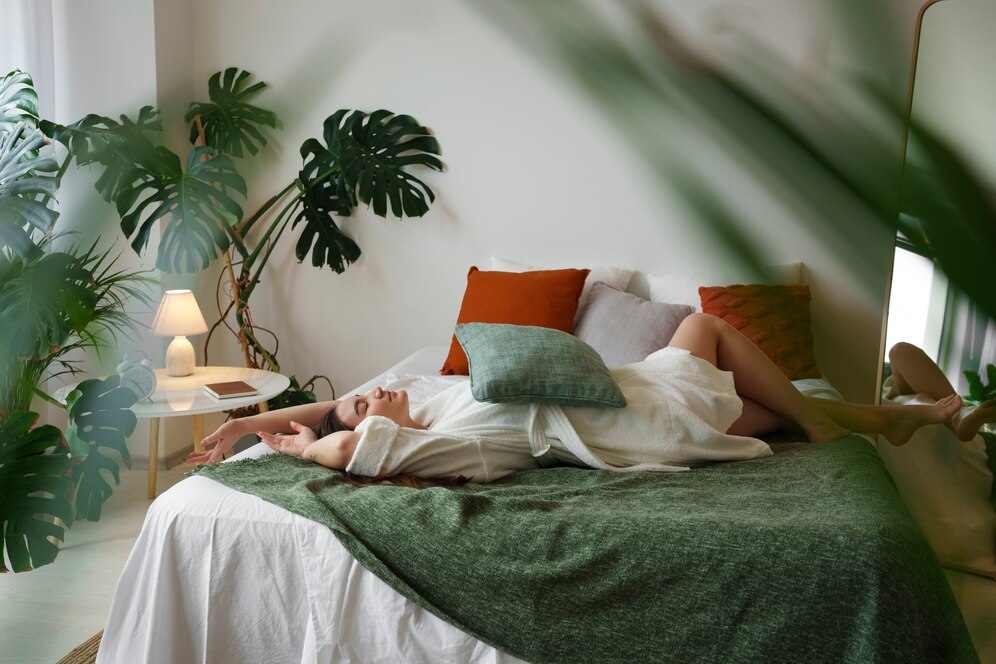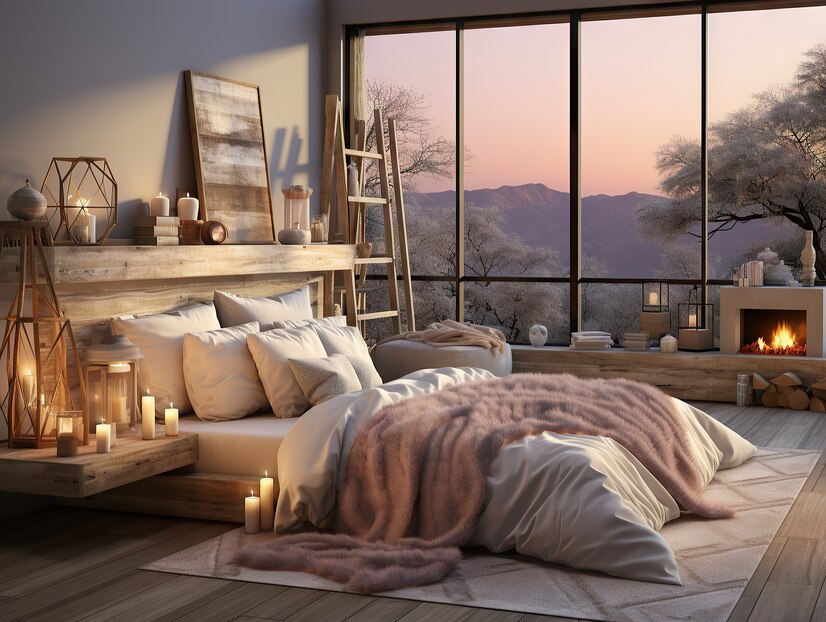
How to Design a Serene and Relaxing Bedroom
Your bedroom is more than a place to sleep. It should be your sanctuary, a retreat from daily stress. How you design your bedroom can greatly affect your mood, relaxation, and well-being. Transform your bedroom into a personal oasis. Use modern decor, choose the right colors, and create a relaxing sleep space.
In this guide, we’ll look at key parts of bedroom design. We’ll cover choosing colours, furniture, lighting, textures, and thoughtful decor.

The Key Elements of a Relaxing Bedroom
A well-designed bedroom is a balance of aesthetics and functionality. Here are the essential components:
1. Choosing the Best Bedroom Colour Schemes
Colour plays a vital role in setting the tone for relaxation.
- Cool and Calming Tones: Shades of blue, green, and lavender create a tranquil atmosphere, helping to lower stress levels and encourage restful sleep.
- Neutral Palettes: Soft whites, greys, and beiges provide a soothing, modern feel while complementing various decor styles.
- Earthy Tones: Warm browns, muted terracottas, and soft sage greens bring a natural, grounding effect, ideal for fostering a sense of peace.
Pro Tip: Avoid overly bright colours like bold reds and oranges, as they can be too stimulating for a sleep-friendly environment. If you love vibrant hues, consider incorporating them as subtle accents.
2. Modern Bedroom Decor for a Minimalist Look
A clutter-free bedroom fosters a peaceful mindset. Embrace modern design elements:
- Minimalist Furniture: Opt for sleek, streamlined pieces that enhance space efficiency and create a contemporary look.
- Functional Storage: Under-bed drawers, built-in wardrobes, and floating shelves help reduce clutter while maintaining an elegant aesthetic.
- Natural Materials: Wooden bed frames, linen bedding, and cotton rugs bring warmth, texture, and an organic feel to the room.
- Statement Lighting: A modern bedroom often features pendant lights or sleek bedside lamps that provide both functionality and style.
Pro Tip: Stick to a “less is more” approach—choose a few key decor pieces instead of overcrowding your space with excessive accessories.
3. The Importance of Lighting in a Relaxing Sleep Space
Lighting has a profound impact on your sleep quality and relaxation levels.
- Soft, Warm Lighting: Choose warm-toned LED bulbs for bedside lamps to create a cosy and inviting atmosphere.
- Dimmable Lights: Adjustable brightness helps set the mood for winding down in the evening, reducing exposure to harsh lighting before bed.
- Blackout Curtains: These help block out unwanted light, improving sleep quality, especially for those sensitive to early morning sunlight.
- Layered Lighting: Incorporate a mix of ambient, task, and accent lighting to create a balanced and well-lit space without overwhelming brightness.
Pro Tip: Consider using smart lighting systems that adjust based on the time of day, gradually dimming as bedtime approaches.
Designing for Comfort and Serenity
1. Selecting the Perfect Bedding for Quality Sleep
Your choice of bedding can make all the difference in your sleep quality.
- High-Quality Sheets: Opt for breathable materials like Egyptian cotton, linen, or bamboo, which help regulate body temperature and improve sleep comfort.
- Supportive Mattress & Pillows: Invest in a high-quality mattress that supports your preferred sleeping posture, along with pillows that provide optimal neck and spine alignment.
- Layering: Use soft throws and textured cushions to add cosiness, making your bed feel more inviting.
- Weighted Blankets: For those who experience anxiety or restless sleep, a weighted blanket can provide a comforting sense of security.
2. Incorporating Nature for a Calming Effect
Bringing nature into your bedroom enhances relaxation and improves air quality.
- Houseplants: Peace lilies, snake plants, and lavender improve air circulation and promote calmness, helping to purify the air naturally.
- Natural Scents: Essential oils like lavender, chamomile, and sandalwood aid relaxation, reducing stress and enhancing sleep.
- Nature-Inspired Decor: Wooden furniture, stone accents, rattan accessories, and botanical prints create an organic and soothing environment.
Pro Tip: Keep at least one plant in your bedroom for improved air circulation and mood enhancement. Low-maintenance options like succulents and pothos are great for beginners.
3. Organising Your Space for a Stress-Free Environment
A cluttered space can lead to a cluttered mind, making it harder to unwind and relax.
- Declutter Regularly: Keep only essential items in the bedroom, avoiding unnecessary distractions.
- Use Storage Wisely: Opt for stylish yet functional furniture pieces with hidden storage to maintain a clean and tidy appearance.
- Maintain a Clean Space: A well-organised room promotes relaxation, improves focus, and contributes to better sleep quality.
- Adopt a Nighttime Routine: Dedicate a few minutes before bed to tidying up to create a more peaceful sleeping environment.

Personalising Your Bedroom for Ultimate Comfort
1. Adding Personal Touches Without Overwhelming the Space
A serene bedroom doesn’t have to feel impersonal—small details can make it feel like home.
- Soft Artwork: Hang calming paintings or nature-inspired prints to enhance relaxation.
- Sentimental Items: Keep a few meaningful objects on display, like family photos, cherished books, or heirlooms.
- Cosy Reading Nook: A comfortable chair with a warm throw blanket creates an inviting space for unwinding with a book or tea before bed.
- Custom Textiles: Choose duvet covers, cushions, and curtains that reflect your personality while maintaining a soothing colour scheme.
2. The Role of Sound and Scent in Relaxation
Enhance your sleep environment through sensory elements.
- White Noise Machines: These help mask disruptive sounds, making it easier to drift off into a peaceful sleep.
- Calming Music or Nature Sounds: Playing soft instrumental music, rain sounds, or ocean waves can help you relax before bedtime.
- Scented Candles or Diffusers: Infuse the room with scents that promote relaxation, such as lavender, chamomile, or vanilla.
- Himalayan Salt Lamps: These provide a soft, warm glow while helping to purify the air and promote a serene atmosphere.
Pro Tip: Avoid strong artificial scents that can be overpowering—opt for naturally sourced aromas instead, and be mindful of allergies when selecting candles or diffusers.

Creating Your Perfect Relaxing Sleep Space
Designing a serene and relaxing bedroom is about creating harmony between colours, textures, lighting, and personal elements. By embracing modern bedroom decor, selecting the best bedroom colour schemes, and ensuring a relaxing sleep space, you can transform your bedroom into the ultimate retreat.
Start small—introduce soothing colours, declutter your space, or upgrade your bedding. Prioritise elements that help you feel most relaxed and comfortable. Which of these tips will you implement first? Share your thoughts in the comments below and begin your journey to a more peaceful, sleep-friendly bedroom!